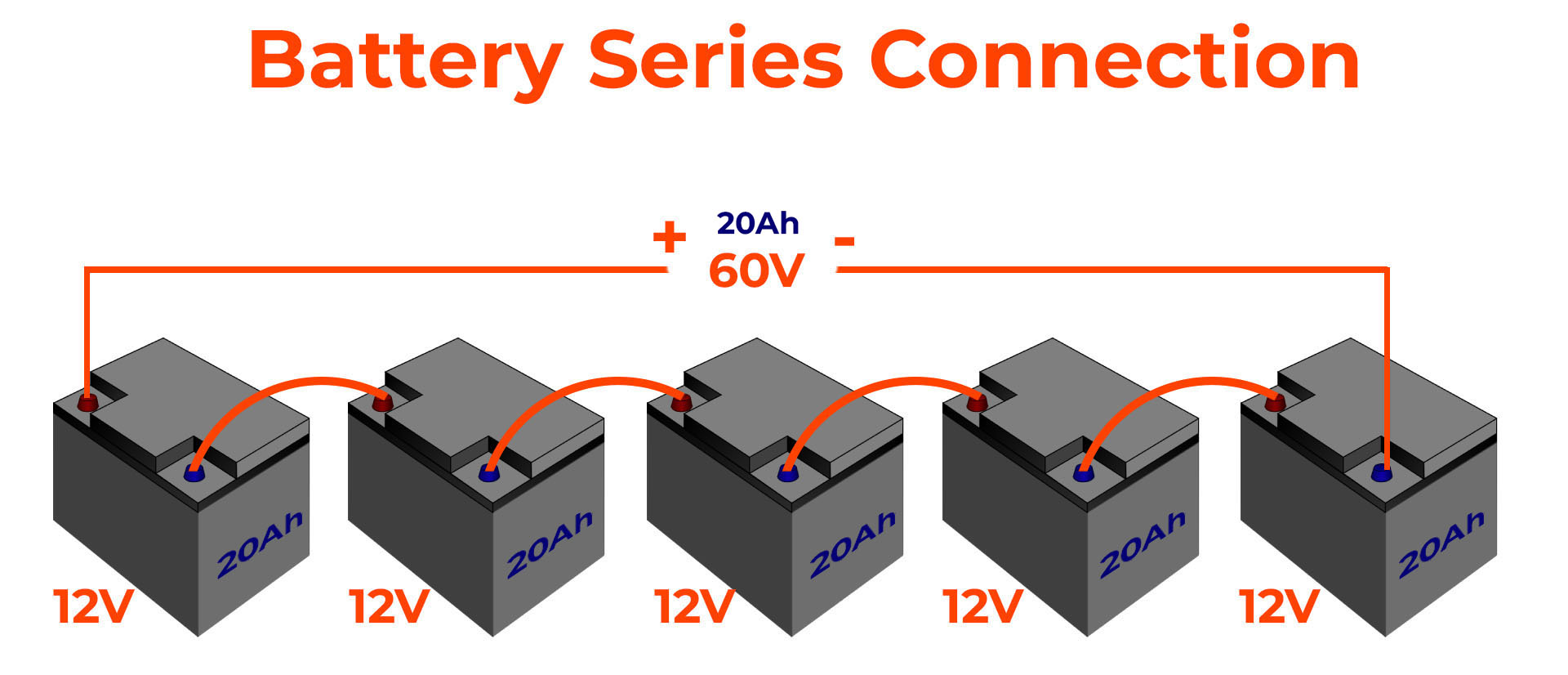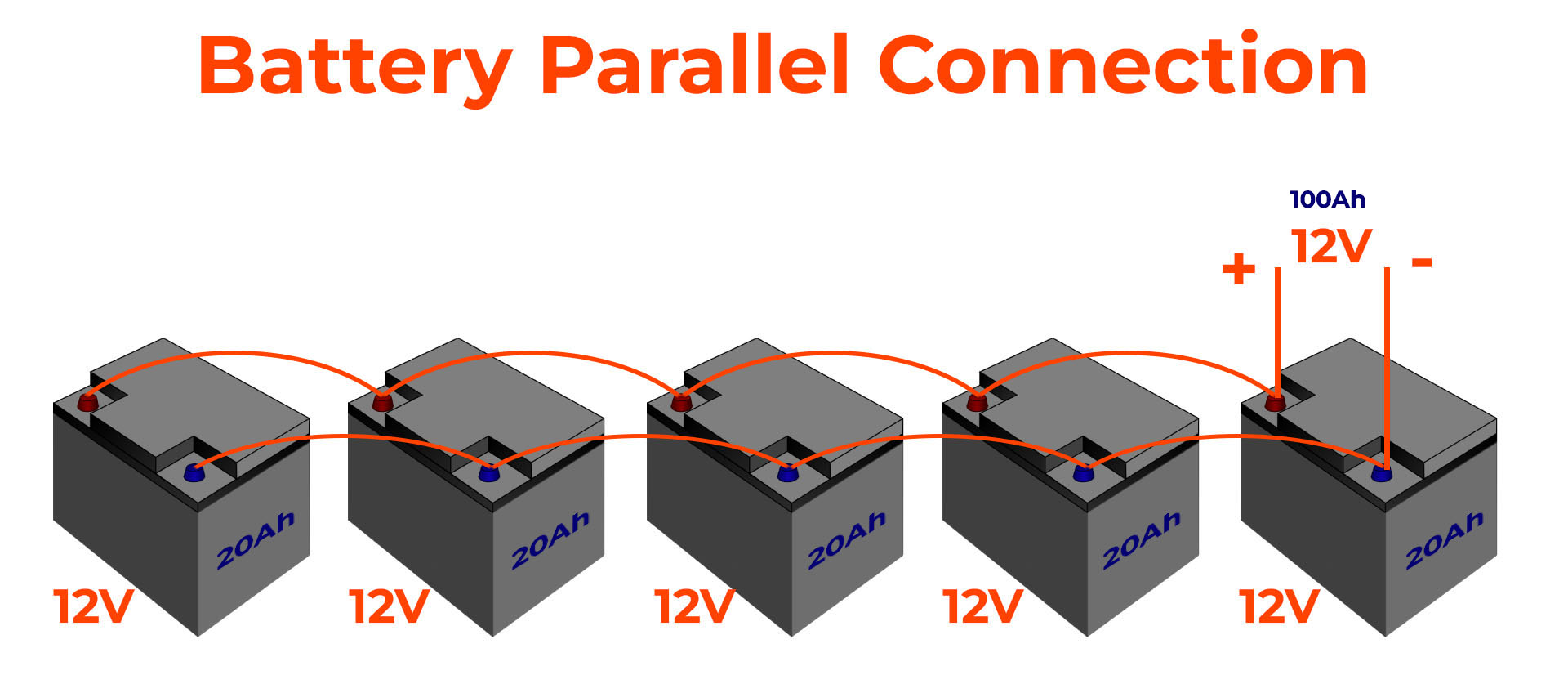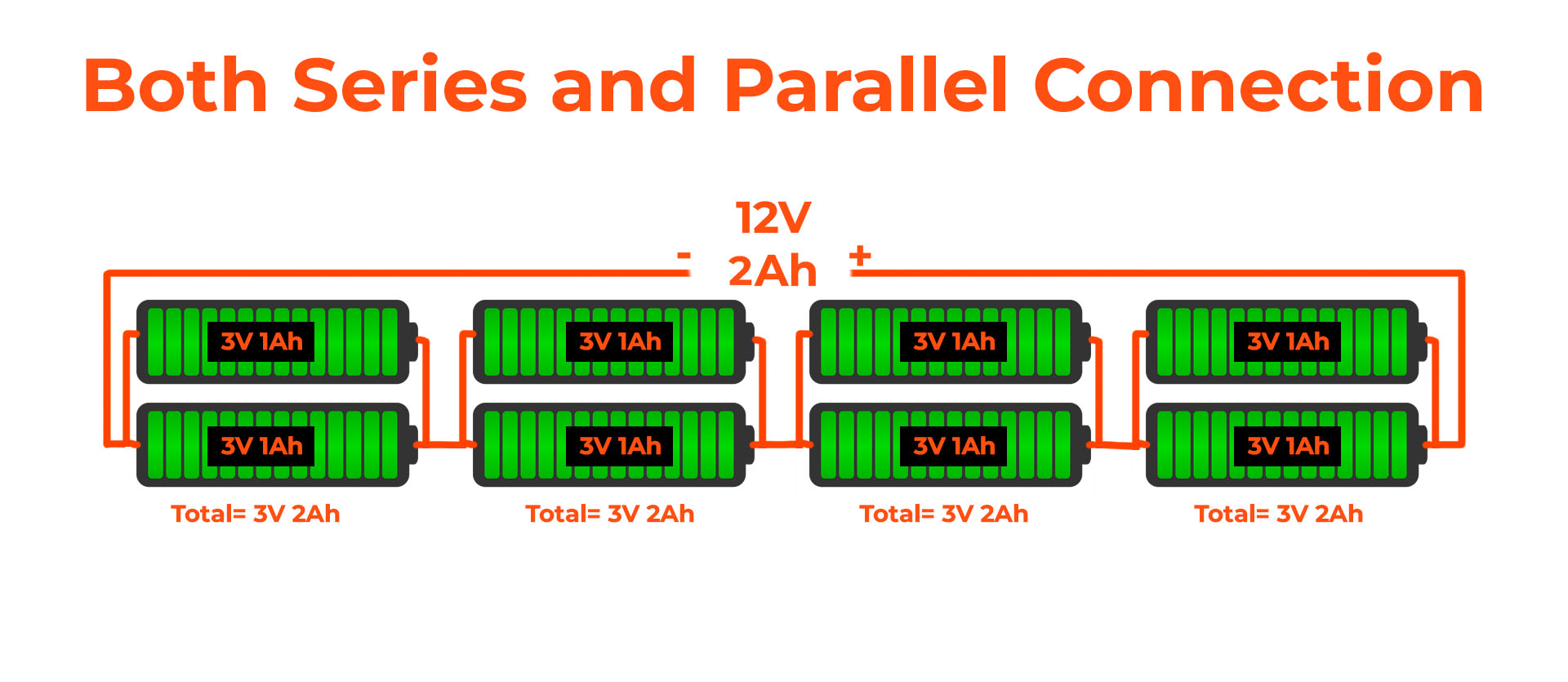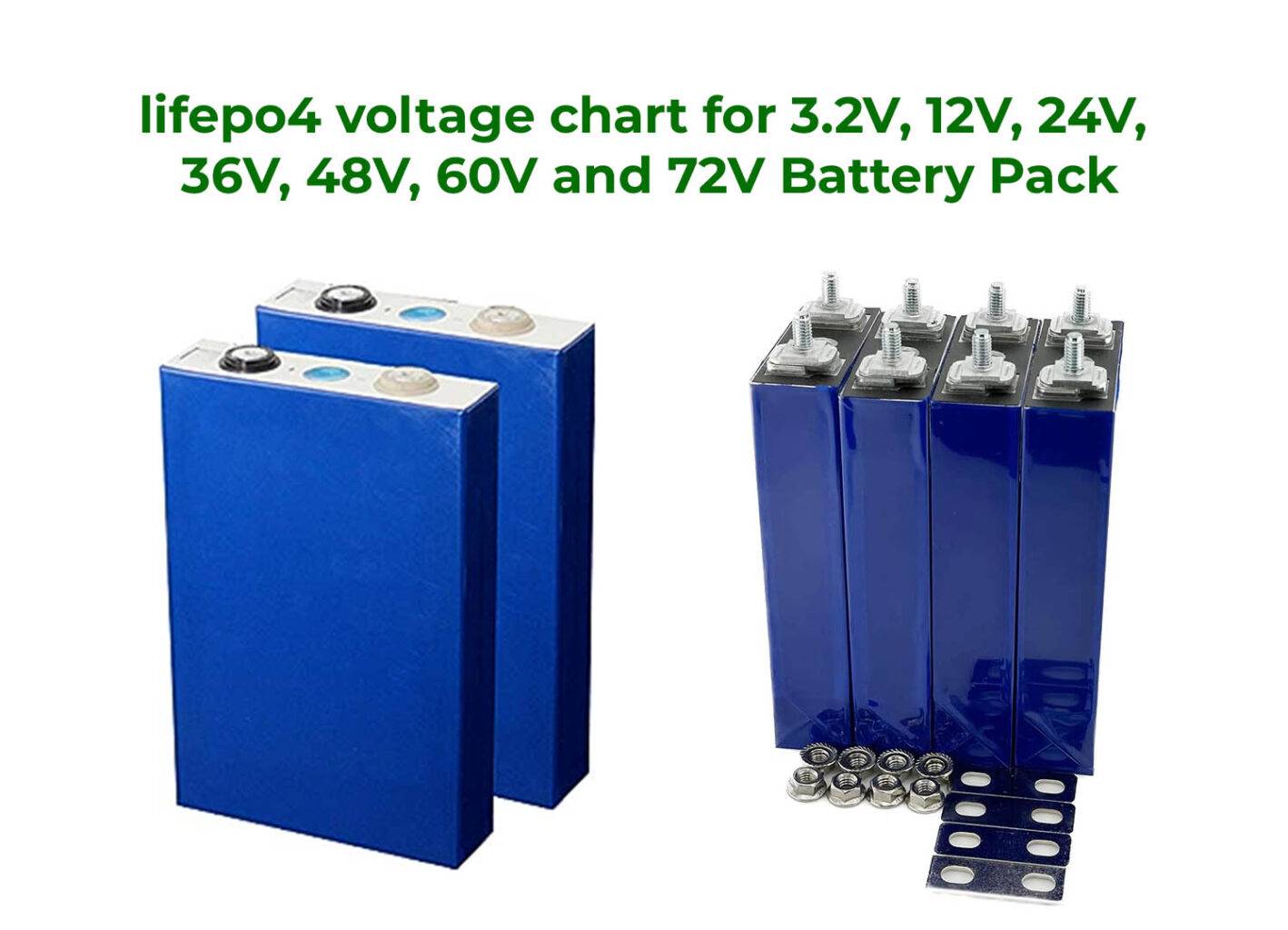Batteries can be connected in two primary configurations: series and parallel. Each configuration has its own advantages and disadvantages, and they serve different purposes based on the desired outcome. Let’s explore all about Batteries in Series vs Parallel configurations:
Batteries in Series:
When batteries are connected in series, the positive terminal of one battery is connected to the negative terminal of another battery. The voltage adds up while the capacity (ampere-hours) remains the same. Here’s a summary of the characteristics of batteries in series:
Advantages:
- Increased Voltage: The total voltage across the series-connected batteries is the sum of the individual battery voltages. This is useful when you need to power devices that require a higher voltage than a single battery can provide.
Disadvantages:
- Same Capacity: The overall capacity of the battery bank remains the same as that of a single battery. This means that while the voltage is higher, the batteries won’t last longer in terms of runtime.
- Greater Risk: If one battery in the series fails, it can disrupt the entire circuit. Also, if the batteries have slight differences in capacity or voltage, it can lead to uneven charging and discharging, which could reduce overall battery life.

Batteries in Parallel:
When batteries are connected in parallel, the positive terminals are connected together, and the negative terminals are connected together. The voltage remains the same, but the capacity (ampere-hours) adds up. Here’s a summary of the characteristics of batteries in parallel:
Advantages:
- Increased Capacity: The total capacity of the battery bank increases, providing longer runtime. This is beneficial for devices that require sustained power over an extended period.
- Better Load Sharing: Batteries connected in parallel share the load more evenly, reducing the risk of individual batteries becoming overburdened.
- Fault Tolerance: If one battery in the parallel configuration fails, the others can continue to provide power, minimizing disruption.
Disadvantages:
- Same Voltage: The overall voltage of the battery bank remains the same as a single battery. If you need a higher voltage, you’ll have to use batteries in series.
- Maintenance Challenges: If batteries have different levels of charge, they can balance unevenly, leading to capacity differences over time.
This are the main things on Batteries in Series vs Parallel connection. Choosing between Batteries in Series vs Parallel connections depends on the specific requirements of the application. If you need higher voltage, go for series. If longer runtime and increased capacity are the priorities, then parallel connections are more suitable. Sometimes, a combination of both series and parallel configurations is used to achieve the desired balance of voltage and capacity.

Batteries in Series vs Parallel Configuration:
In many cases, both series and parallel connections are combined to create a series-parallel configuration. This involves connecting groups of batteries in parallel and then connecting these groups in series. This allows you to achieve both higher voltage and increased capacity. For example, if you have four sets of batteries connected in parallel, each set containing three batteries in series, you get the benefits of both configurations. This approach is often used in larger-scale applications such as electric vehicles, solar energy systems, and backup power systems.

Here’s a table on Batteries in Series vs Parallel configurations:
| Aspect | Batteries in Series | Batteries in Parallel |
|---|---|---|
| Voltage | Adds up: Total voltage is the sum of individual battery voltages. | Same as individual battery voltage. |
| Current | Same across all batteries. | Adds up: Total current is the sum of individual battery currents. |
| Capacity (Ah) | Same as individual battery. | Adds up: Total capacity is the sum of individual battery capacities. |
| Capacity Distribution | Equal distribution among batteries is essential for balanced performance. | Battery capacity variations have less impact on overall performance. |
| Energy | Increases with the sum of individual energy capacities. | Increases with the sum of individual energy capacities. |
| Discharge Rate | Discharge rate is shared among batteries, potentially reducing strain on each battery. | Discharge rate is shared among batteries, potentially reducing strain on each battery. |
| Wiring Complexity | Simple wiring, but requires proper balancing and monitoring. | More complex wiring and potential current distribution challenges. |
| Charging | Charging must be balanced to prevent overcharging of individual batteries. | Charging must be balanced to prevent overcharging of individual batteries. |
| Application | Often used to achieve higher voltage for devices requiring more voltage. | Often used to achieve higher capacity for devices requiring more current. |
| Risk | If one battery fails, it can impact the whole series, leading to system shutdown. | If one battery fails, the others can continue to provide power. |
| Total Voltage | Sum of individual battery voltages. | Same as individual battery voltage. |
Please note that while working on batteries in series vs parallel configurations, proper safety precautions and monitoring are necessary when connecting batteries in either series or parallel configurations to ensure balanced performance and prevent potential hazards.
Examples of Series and Parallel Connections:
1. Household Battery Banks:
In homes and businesses, battery banks used for backup power can be configured in a series-parallel arrangement. This balances the need for higher voltage (series connection) and greater capacity (parallel connection), ensuring a reliable power supply during outages.
2. Electric Vehicles (EVs):
EVs often use a combination of series and parallel connections to achieve the desired balance of voltage and capacity for their battery packs. This design impacts factors like range and performance.
3. Solar Energy Storage:
Solar energy systems frequently use batteries to store the excess energy generated during the day for use during the night or cloudy days. A mix of series and parallel connections helps optimize the battery bank’s capacity and voltage to meet the energy demands.
4. Uninterruptible Power Supplies (UPS):
Data centers and critical infrastructure rely on UPS systems to provide seamless power during electrical grid disruptions. Batteries in these systems are often configured in parallel to ensure extended runtime without compromising voltage stability.
5. Remote and Off-Grid Applications:
For remote areas or off-grid setups, battery systems are configured to provide reliable power. Depending on the energy requirements, series and parallel connections are chosen strategically.
In all these applications, the choice of battery configuration depends on factors like required voltage, capacity, available space, load characteristics, and budget. It’s important to carefully consider these factors and consult with experts when designing battery systems for specific purposes. Bellow is an example of both connections and showing batteries in series vs parallel differences.

More Topics on Batteries in Series vs Parallel Connection
High-Power Applications:
For applications requiring high power output, such as electric power tools or electric propulsion systems in boats, series connections are often preferred. This is because the combined voltage of series-connected batteries can deliver the necessary power while keeping the current within manageable levels.
Balancing and Monitoring:
It’s important to ensure that batteries are balanced in terms of state of charge and voltage. In series connections, any imbalances can lead to one battery being overcharged or over-discharged, affecting its lifespan. In parallel connections, uneven battery capacities can cause unequal current sharing, leading to premature failure of weaker batteries. Proper battery management systems (BMS) are used to monitor and balance batteries in complex setups.
Capacity vs. Voltage Trade-off:
The decision to go for series, parallel, or a combination of both depends on your specific needs. If you need higher voltage for a particular device, series is the way to go. If you need longer runtime or more capacity, parallel connections are suitable. In some cases, you might need to strike a balance between voltage and capacity, and that’s where a series-parallel configuration comes into play.
Safety Considerations:
When working with batteries, especially in series connections, it’s crucial to be mindful of safety. Higher voltage systems carry higher risks of electrical shock, short circuits, and fire hazards. Adequate insulation, proper fusing, and following manufacturer guidelines are essential.
Economic and Environmental Factors:
The cost of batteries and their maintenance should also influence your decision. Sometimes, a series-parallel configuration might be more cost-effective than simply adding more batteries. Additionally, considerations about the environmental impact of disposing of or recycling batteries should be taken into account.
Renewable Energy Systems:
In renewable energy systems mostly like solar and wind power installations, battery configurations are crucial for storing excess energy generated in peak production periods. Parallel configurations are often used to increase storage capacity, which is allowing the system to store more energy for later use. This ensures a stable power supply even when the renewable energy source isn’t actively generating electricity.
Emergency Lighting Systems:
Emergency lighting systems in buildings, especially in critical areas like hospitals or evacuation routes, often utilize batteries to provide illumination during power outages. These systems typically employ batteries in a combination of series and parallel connections to balance the need for higher voltage and longer runtime.
Golf Carts and Electric Scooters:
Golf carts, electric scooters, and similar vehicles require both adequate voltage and capacity. These applications often use battery banks composed of multiple batteries connected in series to achieve the necessary voltage while maintaining parallel connections to increase capacity. This ensures the vehicles can operate effectively and cover reasonable distances on a single charge.
Educational Demonstrations:
Series and parallel battery configurations are often used in educational settings to teach students about basic electrical principles. Simple setups can illustrate how voltage and capacity change with different connections, helping students understand the practical implications of these concepts.
DIY Projects and Hobbies:
Hobbyists and DIY enthusiasts often experiment with battery configurations for various projects, such as remote-controlled vehicles, electronic gadgets, and custom power banks. Depending on the desired outcome, they might choose to connect batteries in series, parallel, or a combination of both to achieve their project goals.
Continuous Innovation:
As battery technology continues to evolve, new configurations and approaches emerge. For example, advancements in lithium-ion technology have led to innovative designs that optimize capacity, voltage, and energy density. Engineers and researchers are constantly exploring novel ways to arrange and connect batteries to meet the ever-growing demands of modern technology.
Remember that proper battery management, safety precautions, and adherence to manufacturer guidelines are crucial regardless of the chosen configuration. Whether you’re designing a complex energy storage system or simply creating a DIY project, a solid understanding of series and parallel connections will empower you to make informed decisions and achieve the desired outcomes.

Few shot terms on batteries in series vs parallel:
1. Voltage Boost: Batteries in Series vs Parallel
Explore how connecting batteries in series increases voltage, while parallel connections impact capacity. Understand their implications in various applications.
2. Balancing Act: Managing Batteries in Series and Parallel Configurations
Delve into the challenges of maintaining balance and ensuring proper charging in both series and parallel battery setups. Learn about the strategies to avoid issues.
3. Performance Impact: Series and Parallel Battery Connections
Investigate how the performance of battery banks differs in series and parallel connections. Analyze factors such as capacity, voltage, and overall resilience.
4. Backup Power Design: Choosing Between Batteries in Series and Parallel
Examine the considerations for designing backup power systems using series or parallel battery connections. Determine which configuration suits different energy and load requirements.
5. Fault Tolerance: Evaluating Reliability in Series vs Parallel Battery Arrays
Assess the reliability of battery arrays when a single battery fails in series and parallel configurations. Understand which setup offers better resilience.
6. Hybrid Approaches: Mixing Series and Parallel Connections for Optimal Power
Discover how hybrid configurations, combining elements of series and parallel connections, can provide customized solutions for specific power needs.
7. Battery Bank Expansion: Scaling Up with Series and Parallel Configurations
Learn about the considerations when expanding battery banks using either series or parallel connections. Explore the effects on overall voltage and capacity.
8. Optimizing Energy Delivery: Load Matching with Series vs Parallel Batteries
Compare how series and parallel connections affect the delivery of energy to different loads. Find out how each configuration suits varying energy demands.
9. Advanced Applications: Complex Battery Setups Beyond Series and Parallel
Explore intricate setups that go beyond simple series and parallel connections. Dive into multi-layered configurations for specialized applications.
10. Efficiency Trade-offs: Efficiency Considerations in Batteries in Series vs Parallel
Investigate the trade-offs in efficiency when using batteries in series and parallel connections. Examine factors like power losses and conversion efficiency.
FAQ on Batteries in Series vs Parallel Connection:
Frequently Asked Questions on Batteries in Series vs Parallel Connections
1. What is the main difference batteries in series vs parallel?
In series, batteries are connected end-to-end, resulting in increased voltage while the capacity remains constant. In parallel, batteries are connected side by side, leading to increased capacity while the voltage remains the same.
2. Why would I connect batteries in series?
Connecting batteries in series is done to increase the total voltage output. It’s commonly used in applications requiring higher voltage levels than a single battery can provide, such as in some electric vehicles.
3. When should I connect batteries in parallel?
Parallel connections are useful when you need to increase the overall capacity of the battery bank. This is helpful in applications that require higher current delivery or extended runtime, like in backup power systems.
4. What happens to voltage and current in batteries connected in series?
Voltage adds up in series connections, resulting in higher total voltage. Current remains the same across all batteries in series.
5. How does capacity change in parallel connections?
In parallel, the capacity of the battery bank increases. When you connect batteries with the same capacity in parallel, their capacities add up.
6. Are there risks to consider in series connections?
Yes, if one battery fails in a series connection, it can disrupt the entire circuit, leading to system shutdown or imbalance. Proper monitoring and balancing are crucial in series connections.
7. What about risks in parallel connections?
While the risk of total system shutdown due to a single battery failure is lower, parallel connections can face challenges in distributing current equally among batteries. Unequal current distribution can affect battery lifespan and overall performance.
8. Which configuration is suitable for a higher energy output?
Both series and parallel connections can increase energy output. In series, the energy output increases due to higher voltage. In parallel, the energy output increases due to higher capacity.
9. Are there applications that use a combination of series and parallel connections?
Yes, many complex systems, like some renewable energy setups, use a combination of series and parallel connections to achieve the desired balance of voltage, capacity, and current.
10. How does charging work in both configurations?
Both configurations require careful balancing during charging. In series, it’s important to ensure that each battery reaches the same charge level to prevent overcharging. In parallel, ensuring equal charge and discharge rates among batteries is crucial for balanced performance.
11. Which configuration offers better resilience to battery failure?
Parallel connections tend to offer better resilience. If one battery fails, the others can continue providing power. In series, a single battery failure can impact the entire circuit.
12. How do I choose between series and parallel connections for my project?
Consider your voltage and capacity requirements, potential risks, and the overall system design. If you need higher voltage, go for series; if you need more capacity, go for parallel.
13. Can I connect more than two batteries in series or parallel?
Yes, you can. Just ensure that you maintain proper balancing and monitoring to prevent issues related to unequal voltage, capacity, or current distribution.
Conclusion:
Remember that safety and proper management are crucial when working with battery configurations, especially in more complex setups involving series and parallel connections.
If you need more info about batteries in series vs parallel connections don’t hesitate to contact us or you can leave a comment. We will try to give you answer any of your questions on batteries in series vs parallel connections. Thanks.







Question for you- If you connect 4 batteries in series each having 3 volt and 1Ah then what will be total volt and Ah? (Post your answer as comment)